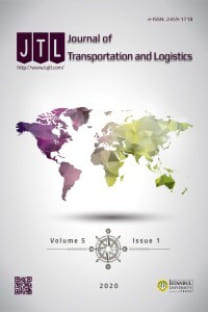Deniz Ticaret Odası Yıllık Sektör Raporlarının Tahminleme Yöntemleri Açısından İncelenmesi
Bu çalışmada Türkiye Deniz Ticaret Odası sektör raporlarında tahminleme yöntemlerinin ne derece kullanıldığı, bu raporların denizcilik ile ilgili kurum/şirketlerin yatırım kararı alırken ne denli göz önüne aldığı belirlenmeye çalışılmıştır. Tahminleme yöntemlerinin incelenmesi sonucunda Deniz Ticaret Odası’nın sektör raporlarının “ortalama alma” yöntemi dışında herhangi bir metodu kullanmadığı tespit edilmiştir. Bu gözlemin ardından dört büyük denizcilik şirketinin (Maersk, Msc, Uasc, Cma-cgm) tahminleme ve pazar araştırması yapan ilgili yöneticisiyle, yarı yapılandırılmış (semi-structured) röportaj gerçekleştirilmiştir. Bu görüşmeler ertesinde İstanbul’da bulunan Deniz Ticaret Odasına gidilmiş, raporu koordine eden ve aynı zamanda rapordaki ekonomik değerlendirme bölümünü hazırlayan Kpt. Ahmet Tagmaç ile rapor hazırlama süreci, raporun amacı, kaynak belirlenmesi ve sektörün rapordan beklentileri hakkında röportaj yapılmıştır. Son olarak Deniz Ticaret Odası 2013 raporu bir yıl önce(2012) hazırlanan ve denizcilik sektörünün 2020 için tahminlemesini yapan DNV (Det Norske Veritas) 2020 denizcilik raporuyla karşılaştırılmıştır. Tüm bu kaynak taraması, karşılaştırma ve röportajlardan sonra Deniz Ticaret Odası sektör raporlarının bilgiyi tarafsız, güvenilir ve eksiksiz sunma konusunda yetkin olduğu fakat tahminleme methodlarını yeterince kullanmadığı saptanmıştır. Röportaj yapılan şirketlerde bunun altını özellikle çizmiştir. Bu eksiklik, raporu hazırlayanlar tarafından amaçlarının tahminleme yapmak olmadığı; sadece sektöre bilgi vermek olduğu şeklinde yorumlanmıştır.
Anahtar Kelimeler:
Tahmin, tahminleme teknikleri, pazar araştırması, Deniz Ticaret Odası yıllık raporu
Evaluation of Annually Report of Chamber of Shipping of Turkey With Respect to Forecasting Techniques
In this study, Chamber of shipping annually reports has been examined that how much forecasting techniques were used in and whether shipping companies/intuitions practice them during the investment process and company internal decisions Literature on forecasting techniques were reviewed. Turkish Chamber of Shipping Reports (CSR) 2013 has evaluated in terms of using the techniques. It was seen that only “average method” is used in the reports. After gathering this result four big shipping companies’ (Maersk, Msc, Uasc, Cma-cmg) manager, who are somehow or directly responsible for companies forecasting and market research issues, were interviewed The interviews were held by managers created some questions that should be asked to Chamber of Shipping in İstanbul. As a last step, we held an interview with Capt. Ahmet Tagmaç in İstanbul, who is coordinator of the report team and additionally prepared the economical evaluation chapter for the CSR and were talked about report preparation process, aims of reports, resource determination criterias and expectation of the shipping sector from the CSR. The last step of the study is to compare Turkish Chamber of Shipping report with another shipping report which was prepared in 2012 by DNV (Det Norske Veritas) which has a projection of shipping sector to 2020. We came a conclusion that when CSR was examined in respect of data quality, reliability and quantity the reports so much enough. It also has been confirmed during the interview with managers. Interviewees also highlighted the capability of the reports. However, when forecasting and market research techniques is considered, the reports are not enough. The lack of methods is interpreted by the Capt. Tagmaç that Chamber’s aim is not to make forecasts or research of any kind but to inform the sector.
Keywords:
Forecasting, forecasting techniques, market research, Turkish Chamber of Shipping’s annual report,
___
- Benkachcha.S, Benhra.J, El Hassani.H. (2013). Causal Method and Time Series Forecasting based on Artificial Neural Network. International Journal of Computer Applications.75: 3743
- Bhar L. M., Sharma V. K. Time Series Analysis. Indian Agriculture Statistic Institute, New Delhi
- DNV Shipping Report 2020, http://www.dnv.nl/binaries/shipping%202020%20%20final%20report_tcm141530559.pdf (15.03.2015)
- Duru, O. (2008) Forecastıng in Shıppıng Freıght Market, Catalyst Countrıes and Future Scenarios. Journal of Marine and Commerce. Kobe University, Japan Kress, G.J and Snyder J., (1994) Forecasting and Marketing Analysis Techniques. London: Quorum books
- Makridakis, G. (1998). Forecasting, Planning and Strategy for 21st century. New York: The Free Press New York
- Malhotra, N.K. (2004) Marketing Research Third Edition. New Jersey: Pearson Educational International
- Polat, C. (2007) the Role of Forecasting and Its Potential for Functional Management: A Review from the Value Chain Perspective 9. The journal of Social Science. Dokuz Eylül Universty
- Stopford, M. (2009), Maritime Economics, Third Edition. London: Taylor and Francis Group
- Shipping Report of Turkey Chamber of Shipping 2013 http://www.denizticaretodasi.org.tr/sayfalar/sektorraporu. aspx (05.02.2015)
- Thomas, R. (1997). Quantitative methods for business studies. Hertfordshire: Prentice hall Europe
- Topçu, Y.I., Kabak Ö., (2014-2015) Operation Research Lecture Notes
- Başlangıç: 2015
- Yayıncı: İstanbul Üniversitesi
